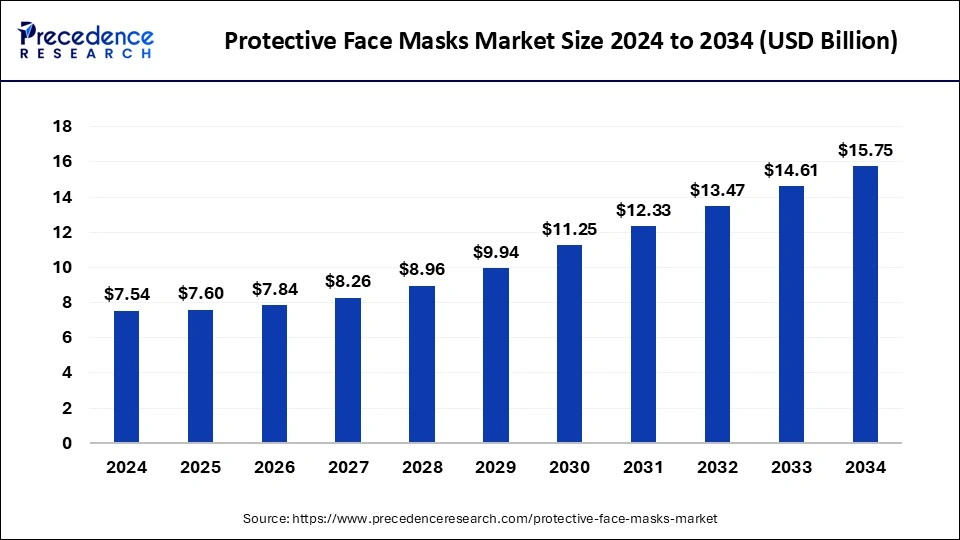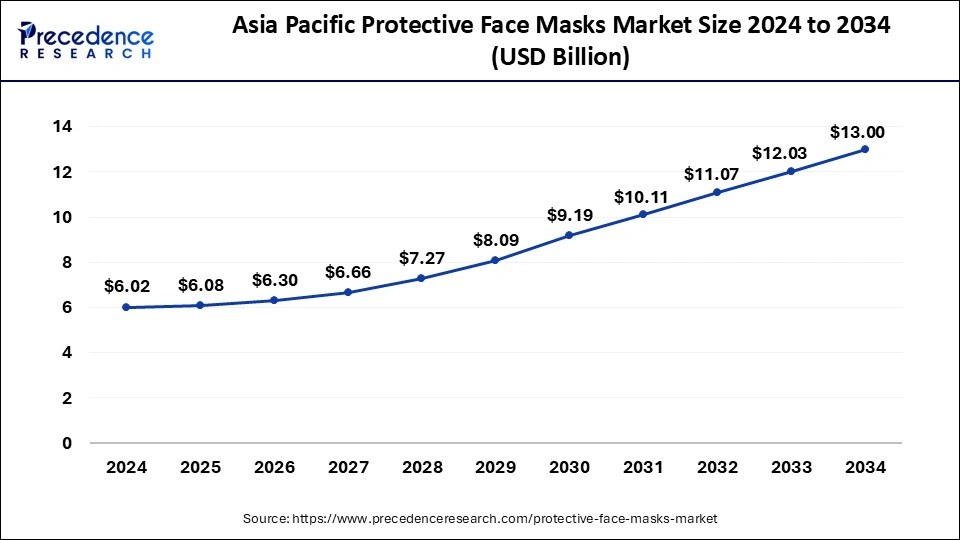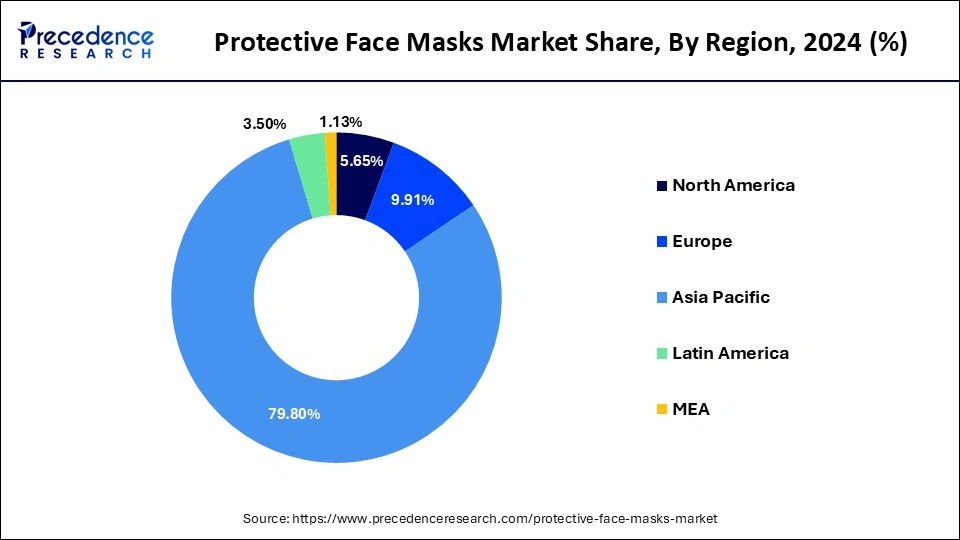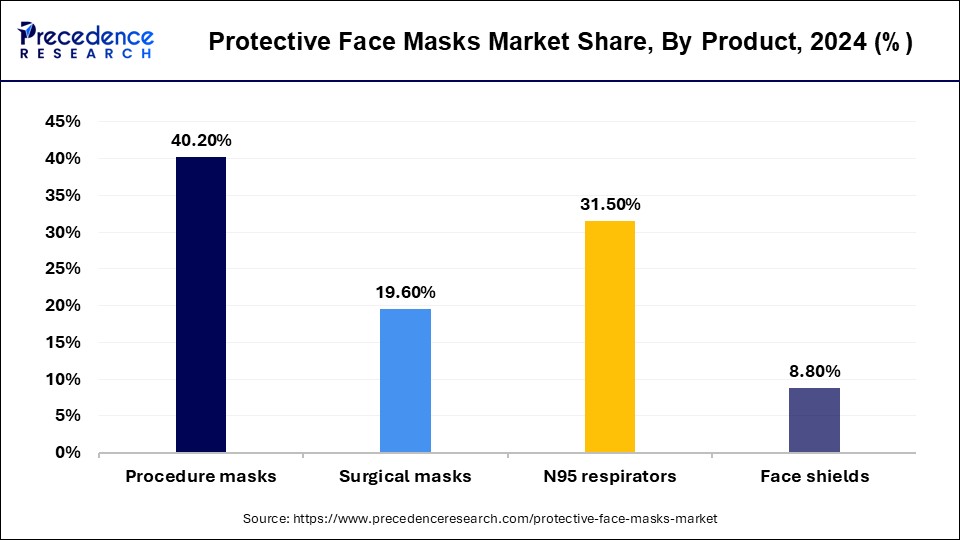August 2024
The global protective face masks market size is evaluated at USD 7.60 billion in 2025 and is forecasted to hit around USD 15.75 billion by 2034, growing at a CAGR of 8.44% from 2025 to 2034. The Asia Pacific market size was accounted at USD 6.02 billion in 2024 and is expanding at a CAGR of 8.80% during the forecast period. The market sizing and forecasts are revenue-based (USD Million/Billion), with 2024 as the base year.
The global protective face masks market size accounted for USD 7.54 billion in 2024 and is predicted to increase from USD 7.60 billion in 2025 to approximately USD 15.75 billion by 2034, expanding at a CAGR of 8.44% from 2025 to 2034. The need for protective masks in airports, aircraft, and other transportation hubs is expected to persist as international travel picks up. This drives the growth of the protective face masks market.

The Asia Pacific protective face masks market size was exhibited at USD 6.02 billion in 2024 and is projected to be worth around USD 13.00 billion by 2034, growing at a CAGR of 8.80%.

Asia Pacific led the market with the largest share in 2024. When the COVID-19 pandemic struck, the region’s government enacted laws requiring face masks and urged people to wear them to stop the virus's spread. This resulted in a sharp increase in the demand for protective face masks. Asia Pacific is a significant center for producing protective face masks, ranking China among the world's top producers. Many manufacturers increased output during the pandemic's peak to fulfill the skyrocketing demand nationally and worldwide. Policies governing protective face masks differ throughout Asia Pacific nations. Governments, however, have implemented policies to guarantee the caliber and security of masks made and distributed inside their borders.

Latin America is seen to grow at the fastest rate during the forecast period. The market for protective face masks saw a significant expansion due to the spike in demand during the pandemic. To fulfill this demand, some firms increased their output. However, the market dynamics might have changed as vaccination rates rose and the pandemic changed. Distribution routes for protective face masks include pharmacies, internet merchants, pharmacies, and medical supply stores. This distribution environment has changed to reflect shifting customer tastes and market dynamics.
The COVID-19 epidemic has created an unprecedented global demand for masks, the main driver of the protective face mask industry. Corporations, governments, medical facilities, and private citizens have all bought masks to stop the infection from spreading. There are many different kinds of products in the protective face masks market, including fabric masks, N95 respirators, surgical masks, and more. Due to their superior filtration efficiency, N95 respirators have attracted much attention and are now the go-to choice for healthcare professionals and high-risk environments.
Guidelines and regulations have been issued by regulatory authorities such as the FDA in the United States and other similar organizations globally to guarantee the safety and effectiveness of masks. It has been essential for manufacturers and distributors to abide by these laws. Despite the stringent regulatory framework, there is an increase in demand for masks. This has often caused problems in the production process, shortages of raw materials, and disruptions in the supply chain. The general public's acceptability and uptake of mask wear impact dynamics of the protective face masks market.
Public health initiatives, governmental regulations, and cultural aspects have significantly impacted how consumers use masks. Demand spikes have occurred in various locations at different phases of the pandemic, resulting in a global protective face masks market. This circumstance sparked creativity and initiatives to boost production capacity around the world. The dynamics of international trade and supply chains impact mask distribution globally.
| Report Coverage | Details |
| Growth Rate from 2025 to 2034 | CAGR of 8.44% |
| Market Size in 2025 | USD 7.60 Billion |
| Market Size by 2034 | USD 15.75 Billion |
| Base Year | 2024 |
| Forecast Period | 2025 to 2034 |
| Segments Covered | Type and End-use |
| Regions Covered | North America, Europe, Asia-Pacific, Latin America, and Middle East & Africa |
Occupational safety
The materials used to make protective face masks should be safe for extended skin and respiratory system contact. This includes ensuring the materials are hypoallergenic, non-toxic, and devoid of dangerous chemicals or other elements that can endanger the wearer's health. Using protective face masks effectively requires a proper fit. In addition to not offering enough protection, ill-fitting masks can irritate or annoy the wearer, which may reduce adherence to safety precautions.
Overly tight masks can obstruct airflow, causing discomfort or breathing problems for the person wearing them. On the other hand, masks lacking appropriate filtering capacity might not provide enough protection against airborne threats found in the workplace. The protective face masks market caters to these minute requirements, appealing to a wider consumer base.
Disruption of social interactions
Face masks can be a communication barrier because they mute voices and cover facial emotions, which makes it more difficult for people to understand one another, especially in loud settings or for those who are hard of hearing. This disturbance might result from misunderstandings, annoyance, and a decline in the caliber of social interactions. The use of masks creates an obstacle that could reduce people's natural relationships with one another.
People may be less likely to strike up a conversation or participate in social activities because they believe it is challenging to communicate and because wearing a mask for an extended time can be uncomfortable. A sense of social distancing may bring on this unease, the incapacity to communicate through facial expressions, or worries about one's appearance when donning a mask. This significantly challenges the growth of the protective face masks market.
Innovation and product development
Businesses are investing in creating masks with improved filtration capabilities to offer superior defense against airborne particles, such as pollution and viruses. This involves the application of sophisticated synthetic textiles, electrospun polymers, and nanofibers—materials that provide greater filtration effectiveness without sacrificing breathability. This is made possible by new technologies and innovations in the protective face masks market.
Face masks are becoming a daily need, and as a result, there is an increasing need for protective and fashionable masks. In response to this demand, businesses provide various stylish and personalized designs with multiple colors, patterns, and embellishments. Manufacturers are utilizing innovative design approaches and ergonomic principles to achieve a snug yet comfortable fit for a wide range of face shapes and sizes. Breathable fabrics, nasal wires, and adjustable straps may be used.
The procedure masks segment held a dominating share of the protective face masks market in 2024 and is expected to continue this dominance over the forecast period. Procedure masks are a kind of protective face mask frequently used in medical settings, especially during operations, medical procedures, and other activities where there is a chance of exposure to infectious agents or bodily fluids. These masks keep potentially dangerous particles, liquids, and microbes from spreading away from the wearer and other people. Procedure masks hold a substantial market share in the protective face masks industry because they are widely used in various healthcare settings, such as clinics, hospitals, dentistry offices, and laboratories. The materials used to make procedure masks are usually multilayered, such as non-woven cloth, which offers fluid resistance and filtration.

Procedure masks have different filtering efficiencies based on how they are made and designed. Nonetheless, they create a barrier against droplets and big particles, even though they might not offer as much protection as respirators like N95 masks. A barrier against bodily fluids and blood frequently seen in hospital environments is built into many procedure masks. During medical treatments, this fluid resistance aids in preventing exposure and contamination. Since healthcare personnel often have to wear procedure masks throughout their shifts, they are typically made to be comfortable to wear for extended periods. To facilitate simple breathing without sacrificing protection, they ought to be breathable.
The hospitals & clinics segment held the largest share of the protective face masks market in 2024. Due to their large patient volumes and the requirement to shield patients and healthcare personnel from airborne diseases, hospitals are the primary locations where protective face masks are used. They frequently wear various masks, such as N95 respirators, surgical masks, and other respiratory protection gear. Protective face masks are also used at medical clinics, such as general practitioner offices, specialty clinics, and outpatient facilities, to stop the transmission of illnesses among staff members and patients. Masks may be used in these institutions for several purposes, including minor surgeries, diagnostic procedures, and patient examinations. Protective face masks are frequently used in nursing homes, assisted living institutions, and other long-term care facilities to safeguard individuals who could be especially susceptible to illnesses.
Dental offices use protective face masks to shield staff members and patients from infectious organisms, especially during aerosol-generating procedures. These facilities undertake outpatient surgeries and procedures to maintain a clean atmosphere and stop the transmission of infections during medical operations. They also generally utilize protective face masks. During emergency medical responses and transports, emergency medical service personnel (EMS), such as ambulance services and paramedics, use protective face masks to keep themselves and their patients safe. Public health clinics may provide protective face masks to the local population to stop the spread of infectious diseases during disease outbreaks or public health emergencies.
By Product
By End-use
By Geography
For inquiries regarding discounts, bulk purchases, or customization requests, please contact us at sales@precedenceresearch.com
No cookie-cutter, only authentic analysis – take the 1st step to become a Precedence Research client
August 2024
February 2025
April 2025
February 2025